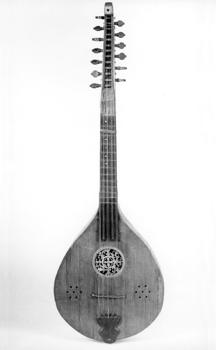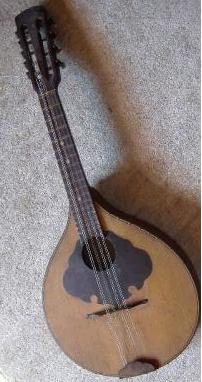|
Origins of the Waldzither The origins of the waldzither probably date back to Arab incursions into Europe during the early Medieval period. Then the flat-backed, 3-string instruments like the 'seh-tar' (meaning 3 strings) must have been both adopted and adapted by western culture, especially as they were easier to construct than the more complex round backs of the lute. By the time of the Renaissance it had more strings, got a larger body, and was called variously 'cittern' 'sister' or 'cither'. The cittern is one of the few metal-strung instruments known from the Renaissance period. It generally has four courses of strings (either singles, pairs or threes), one or more course being usually tuned in octaves, though instruments with more or fewer courses were made. The cittern may have a range of only an octave between its lowest and highest strings, but some also employ "re-entrant" tuning. (The string that is physically uppermost is not the lowest, as with the five-string banjo for example). The tuning and narrow range allow the player a number of simple chord shapes useful for both simple song accompaniment and dances. |
||||
|
Azerbayjani Setar |

Zister Johann Wolfgang Wolf, Crawinkel 1798 |

Zister L. Grau, Erfurt 1846 |

Zister c1800 |
|
| Durng the Renaissance the cittern was a popular instrument across Europe. From the 16th until the 18th century it was a common English barber shop instrument, kept in waiting areas for customers to entertain themselves and others with, and popular sheet music for the instrument was published to that end. One development was the english guitar, with a typically pear-shaped body, a flat base, and a shorter than usual neck. It also often had a carved head. Such guitars made by John Preston have the characteristic 'Preston' or watch-key tuners. It had ten strings, tuned C E GG cc ee gg. A close parallel can be easily seen here with the tuning of the waldzither. Many Englich guitar-citterns are still found in Scandinavia. |
||||

English Guitar John Preston |

Preston's machine-English guitar by John Preston, London, c1790 |
English cittern |
English guitar-cittern |
|
|
In Germany the cittern survived under the names Waldzither and Lutherzither, (from the belief that Martin Luther played this instrument). In the region of Thüringen, the cittern seems to have existed in a time warp throughout the 17th and 18th Century. While citterns elsewhere went through a number of changes, the Thüringer cittern remained very much the same. There were a number of variants with more strings, but the basic nine-stringed early 19th Century Thüringer Zither was very similar to the "standard" renaissance cittern. It also existed under the names Harzzither in the Harz mountains, and Halszither in German-speaking Switzerland. During the 19th Century the instrument became known as the Thüringer Waldzither. Eventually the reference to Thüringer faded out and the instrument became known simply as the Waldzither, literally ‘forest cittern’. |
||||

toggenburger halszither |

Halszither |
Lutherzither c1900 |

Toggenburger Halszither |
Harzzither |
| Two main types of waldzither can still be found today; a) the Bohm type, which have come to be known as Hamburger zithers, having been made in Hamburg, typically built with Preston watch-key tuners and a glass bridge; and b) Thuringer zithers with a more traditional peghead. These were made by a wide range of German manufacturers including Schuster, Meinel & Herold, Migma, Hess and Paulus. They varied in size from base to piccolo, but it is the tenor, with a scale length of around 460mm that is generally found today. |
||||
|
Bohm Type1a |
Otto Herbeck, Breitenfeld 1936 |
Preston Tuners |

Meinel & Herold Thuringer |

Thuringer waldzither |
|
The black and white pictures come from instruments held by the Musical Instrument Museum of the University of Leipzig. |
||||







